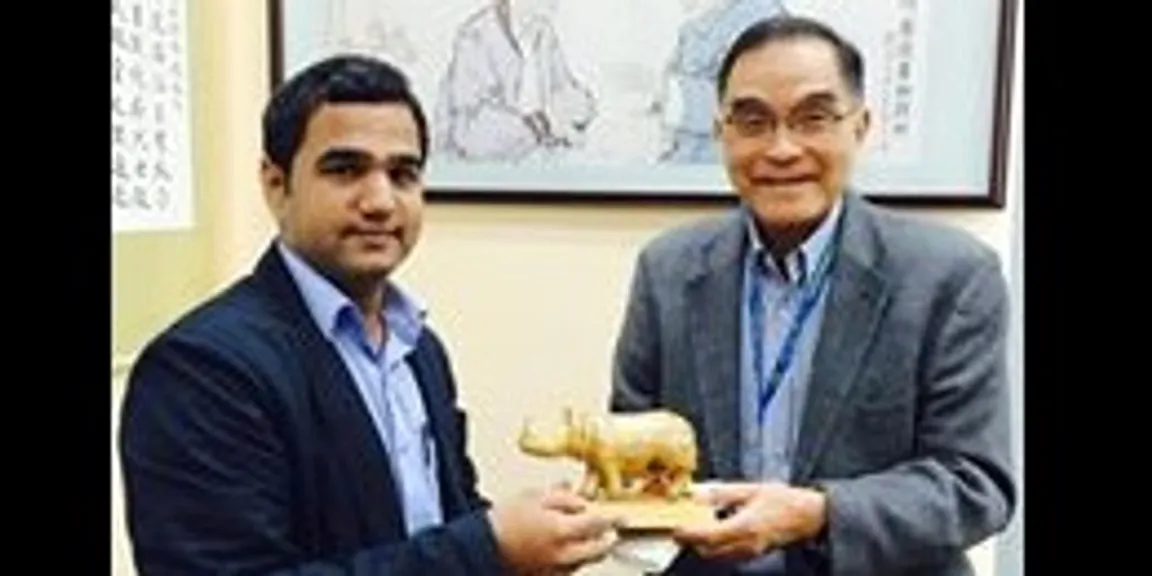

How it feels inside Dragon's Den
Brief note on New Era Emergence: Transition of Identical Twins from India to China
Author: Prof Feng Da Hsuan , Director of Global affairs, University of Macau
Starting this fall, a pair of brilliant young Indian identical twins (named as Ankit Garg and Akhil Garg) will be faculty members of Shantou University of China. Their presence in China could signal a watershed moment for the two Asian giants, India and China. Personally I am very touched by this news, especially seeing how it warmly welcomes the twins, since I served on the Board of Trustees of Shantou University from 2006 to 2016.
India and China, both with huge landmasses, sit next to each other geographically. Both have very large populations, 1.2 billion and 1.4 billion respectively. Until 1962, which can be considered as extremely recent time due to their long histories, the two countries existed peacefully for thousands of years. In fact, in 1950, India was one of the first nations to recognize the so-called “new China,” or the People’s Republic of China (PRC). All that came to a grinding halt in 1962, when Indo-China border conflict erupted. That conflict essentially rendered the relationship of the two countries into a dormant, if not frozen, state. It was only in the beginning of the 21st century that the relationship of the two nations showed any inkling of thawing, albeit very slight, I might add.
In the 21st century, especially when Modi and Xi assumed the top leaderships of these two Asian giants, some preliminary form of communication was initiated. Quite recently, in the Goa Meeting for BRICS nations, both Modi and Xi expressed palpable desire to create a platform for a better and even warm relationship for the two countries. In the words of Xi, such a warm relationship is good for humanity.
However, nations’ relationship began with people-to-people understanding each other’s cultures and ways and means. With that in mind, I would like to share the world the story of “Ankit” and “Akhil”. While the two of them are still young, what they are doing is so spectacular for India and China that it is worth “yelling” about it!
Ankit
Ankit and I in my Macau Office

Immediately after I arrived to the University of Macau (UM) in 2014 September, I met Ankit Garg. At that moment, he was an Assistant Professor of Civil Engineering of the famed Indian Institute of Technology Guwahati (IITG). Invited by Professor Hannah Zhou of UM, he spent several months as visiting scientist at UM. He did his undergraduate studies at IITG (Alma Mater and now faculty in IITG!) and received his Ph.D. from Hong Kong University of Science and Technology (HKUST). The IITs in India which now have some 23 dotting the country, became world famous by the CBS “60 Minutes” show in 2004 (http://www.cbsnews.com/news/imported-from-india/.) In the past, graduates of IITs would pour to North American universities. The fact that Ankit stayed in Asia (HKUST) was a signal of a new era! This time period also coincides with the one of the world’s greatest economic recessions of all time, where many of the western economies suffered.
Moreover, starting this Fall, Ankit will become an Associate Professor of Civil Engineering of Shantou University.
Akhil
Akhil and I in Singapore

As soon as I became friends with Ankit, he immediately told me that he had a twin brother named “Akhil” who had completed his Ph.D. degree in Singapore’s Nanyang Technological University (NTU) and is currently a Post Doc fellow. Months after Ankit told me about his twin brother, I happened to be in Singapore and met Akhil. The moment I met Akhil, I was startled and immediately asked him: “Ankit, what are you doing in Singapore?” I thought Akhil was Ankit! Yes, the two of them are that identical.
Akhil did his undergraduate studies at India’s National Institute of Technology Rourkela (NITR,) another one of top Indian university and his Ph.D. in mechanical engineering from NTU. Now he is an Associate Professor at Shantou University and founder of the Applied Artificial Intelligence Research Group (AAIRG). Judging from my communication with him, and how he described his activities in his Facebook, he is enjoying his life and has a very robust career in Shantou University.
Akhil sent me a rather touching comment about his new career in China. He said that “Having worked in Singapore for post-doctoral and guided Chinese origin students through AAIRG platform, I got a flavor of Chinese culture. During my term in Singapore, I travelled to China on invited lectures to establish collaborations. At the same time, I also visited India several times to deliver seminars. These visits had helped me to become utterly immersed in the working style of Indian and Chinese universities. The uniqueness of research environment in Chinese Universities lies in working in a joint multi-disciplinary team with a special emphasis on young researchers and International collaborations. In addition, there is massive financial support such as Global 1000 talent program and many other talent schemes that encourages and promotes the young researchers to pursue their career in China as faculty members. Despite offered academic positions in Singapore, Japan and US (about to join a Post Doc position at UT Austin), I decided to move to China because of the highly inspiring global academic environment at Shantou University along with the growing manufacturing hub (related to my research), excellent infrastructure (especially high speed network) facilities and also more importantly sense of belongingness that I got from my Chinese colleagues during my regular visits to China. My past one-year experience in Shantou University has been wonderful because it has provided me that excellent platform with focus on "globalization" (Joint Campus with Israel’s world renowned Technion) and "multi-disciplinary" to nurture my abilities and aspirations.”
Recently, I met Ankit in Macau. Our conversation quickly turned to his forthcoming career changed. Speaking with emotions, Ankit began saying that “leaving my beloved India is indeed an emotional roller-coaster for me. In six years of association with IIT Guwahati as student/alumnus/faculty, a truly outstanding university in India, there was ample opportunities for me to collaborate with colleagues in China. Such opportunities made me profoundly aware that if India and China could work as a team by utilizing each other strengths, the world could be a far better place for humanity. In my own diminutive way, I hope I could contribute to this team-work,” said Ankit.
"In my several years of collaboration with my Chinese counterparts, I became aware that the working environment in China can be defined by 4S: "Speed", "Skill", "Scale" and “Smart.” I found from my research that, Chinese engineers/scientists are really good not only in speedy infrastructure development but also in conducting large scale field monitoring and hence, maintenance of infrastructures, which I believe is highly important for India in current scenario. In addition, the other thing that really moved me in China was “safety”. I can proudly say in my five years of travel in China, I never felt unsafe even for 1 second that includes times of my late midnight travel at suburbs of Beijing. The reason why I am optimistic is that, both India and China, being countries of large scale and billions population, there are lot of possibilities to exchange solutions for many problems. Moreover, I have witnessed the rise of young researchers taking leading positions in academics and industry. With my experience as visiting researcher in the University of Leeds and Karlsruhe institute of Technology, I can say with confidence that Chinese researchers and universities are able to adopt two most important characteristics for doing excellent research, which is “multi-disciplinarity (valuing expertise/skills in different field)” and “globalization” at both student and faculty level collaborations. To me, difference in language is a blessing in disguise as it gave me opportunity to better understand their way of life including body language, which is ultimately more important. I am sure working with “4S paradigm” coupled with multi-cultural understanding, I can push myself to think and act beyond my comfort zone and act "Fast" with "Efficiency” by working jointly with the strengths of colleagues from China and other parts of world” concluded Ankit.
In the 20th century, the action of Ankit and Akhil would be unthinkable. While the action of the twins does not a trend make, the transformation from unthinkable to thinkable is what made their new life so exciting. I just learned recently that several hundred of Indian students are now medical students in Jilin University. For sure, although for thousands of years, India and China were peaceful neighbors, history had not been kind to the relationship of India and China in the 20th century. However, towards the end of the century, both nations became “talk of the globe,” primarily because of their respective miraculous economic transformation. Individually, the two countries are already impacting humanity in a palpable manner. If they could work together, despite their differences, they could take the troubled world to a level of tranquility which humanity has never experienced before.
Obviously, talented young people in India and China like Ankit and Akhil must bear this responsibility. One can hope that the conditions can soon be ripened for India and China to allow tens of thousands, maybe even millions of Ankit-like and Akhil-like from both countries who understand what is at stake for humanity, to pursue their dreams and to carry the torch! This is indeed a breathtaking thought!





